 Image source, PA Media
Image source, PA Media
D-Day veterans Bernard Morgan (left), 100, and Jack Mortimer, 100, travelled to Normandy for the 2024 commemorations
King Charles and US President Joe Biden are among world leaders attending ceremonies to commemorate the 80th anniversary of the Normandy landings.
Prime Minister Rishi Sunak and Labour leader Sir Keir Starmer are also in France, along with some D-Day veterans.
The King, Queen and Prince of Wales joined veterans in Portsmouth on Wednesday to mark the anniversary.
What was D-Day and why was it called that?
Troops from the UK, the US, Canada, and France attacked German forces on the coast of northern France, on 6 June 1944.
D-Day was the largest military seaborne operation ever attempted, and marked the start of the campaign to liberate Nazi-occupied north-west Europe.
It involved the simultaneous landing of tens of thousands of troops on five separate beaches in Normandy.
More than a year in the planning, D-Day was originally set to start on 5 June, judged to be the most likely date to combine calm seas, a full moon and low water at first light. However, storms meant it was delayed by 24 hours to 6 June.
The "D" simply stands for "day". D-Day is a military term for the first day of an operation
What happened on D-day?
Airborne troops were dropped behind enemy lines in the early hours, while thousands of ships gathered off the Normandy coast for the main seaborne attack.
Though they were expecting an invasion, German military leaders believed the initial attacks were only a diversionary tactic.
Image source, Getty Images
A deception plan in the weeks ahead of the attack had led them to expect the main invasion further along the coast.
The surprise element helped British troops establish a foothold on a beach codenamed Gold.
In addition, Canadian forces established themselves on another beach - Juno - and the British got on to Sword beach.
American soldiers also managed to land on the westernmost beach - Utah - without major casualties.
But at nearby Omaha beach, the US force suffered serious losses. The naval barrage and bombing raids on the German defences were ineffective and the Americans encountered a crack division of German troops.
Shortly after midnight, three US and British airborne divisions, more than 23,000 men, took off to secure the flanks of the beaches. Myriad naval vessels and landing craft gathered at a location in the Channel dubbed "Piccadilly Circus".
From 06:30, the first five assault divisions were delivered to their beaches under cover of a naval bombardment.
Throughout the day troops landed on the beaches. By midnight, the Allies had secured their beachheads and pushed further inland from Gold, Juno, Sword and Utah.
How many troops took part in D-Day and how many died?
Up to 7,000 ships and landing craft were involved, delivering a total of 156,000 men and 10,000 vehicles to the five beaches along the carefully selected stretch of the Normandy coast.
The landings would not have been possible without the support of massive air and naval forces, which were much stronger than those of the Germans.
But on D-Day alone, as many as 4,400 troops died from the combined allied forces. Some 9,000 were wounded or missing.
Total German casualties on the day are not known, but are estimated as being between 4,000 and 9,000 men.
Thousands of French civilians also perished, mainly as a result of bombing raids carried out by allied forces.
What happened after D-Day?
Although they had got a foothold in France by the end of D-Day, allied forces were for a while at risk of being pushed back into the sea.
They had to keep building up their forces faster than the Germans could reinforce theirs.
Image source, Getty Images
Progress through the narrow lanes and staunchly defended towns of Normandy was slow.
But now outnumbering their enemy and supported by their air superiority, they were able to overcome the considerable resistance - though at a heavy price.
By the time they liberated Paris, in late August 1944, about 10% of the two million allied troops who had by then reached France were dead, wounded or missing.
How many D-Day veterans are still alive?
It is not clear how many D-Day veterans are still alive. All are now in their 90s or 100s.
It is thought there are just over 100 surviving British veterans.
The BBC's Royal Correspondent Sean Coughlan says 23 were taking part in the commemorations in Normandy, and a further 21 attended a memorial event at the National Memorial Arboretum in Staffordshire.
Two dozen US veterans were also expected to make the trip to France, according to the American Battle Monuments Commission, which oversees US cemeteries and monuments abroad.

 9 months ago
38
9 months ago
38









